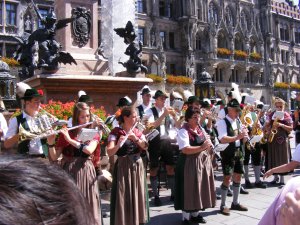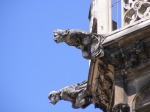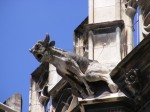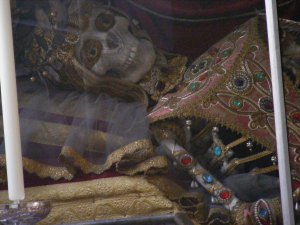
It’s a sad conclusion to reach that the highlights of a world-famous city were a bejeweled skeleton and a glockenspiel, but that’s how we felt about Munich. Alas, the city we encountered fell so far short of fond childhood remembrances I couldn’t wait to get back on the train.
Emerging from the U-Bahn in time to catch most of the noon performance of the glockenspiel in the Rathaus (town hall) tower on the town square, we snagged a café table as the crowd dispersed and planted ourselves in chairs directly in front of the clock tower. Thankfully, before the 1 p.m. performance, the waitstaff put up the café umbrellas, which helped displace the incoming crowds from implanting themselves in our laps. Meanwhile, a traditional Bavarian oomp-pah band, complete with lederhosen and dirndl skirts, entertained the crowds between performances. We tucked into lunch, sipped good German beer, and enjoyed the 1 p.m. performance of the clock’s dancing figurines while the people packed into the town square baked like anchovies on a pizza.

Another look at the world-famous glockenspiel dancing figurines. The netting is to protect the statues from pigeon droppings.
Glockenspiel performances and an ooompah band. Corny as it was, I had hoped they were the beginning of a wonderful day in Munich, which I’d been touting to Michael for the last several months as a “must-see” stop on our way to Budapest. What we found was a city center packed with tourists pushing and shoving their way into every tourist attraction within sight as they flipped through their guide books, looking for the next place to go. Tour groups abounded, traveling in rolling waves akin to fish bait balls. At least fish have a fifth sense that allows them to divert direction or part in the middle if they come upon an immovable object, such as another person. These tourist groups just bowled on through the crowds. More than once I felt like the last ten pin standing.
We sought refuge in St. Peter’s, Munich’s oldest church, off the main square to have a gander at the jeweled skeleton of the martyred St. Munditia, allegedly the patron saint of spinsters.
The highlight of the bus tour was the Nymphenburg Palace and extensive gardens in western Munich where the tour bus stopped again for the requisite photo op and to allow tourists to hop-on or hop-off. The elegant palace, commissioned in 1664 by a Bavarian prince, is centered in a loose horse shoe array of pavilions, stables, and an orangerie.
Baroque mansions built by lesser royalty extend the arms of the palace
complex, encircling a man-made lake complete with swans and lily pads.
We now regret not taking the opportunity to disembark and take a tour of the palace or at least walk around the famous gardens, but at the time we had just plain had it with the tour, the crowds, the heat and Munich in general and wanted – literally – off the bus. Munich had lost its appeal somewhere between the jeweled skeleton and the palace, and nothing – not even a cold beer at a café – could induce us to stay another minute in the city center.
We departed the next morning for Budapest without returning to the city center for another attempt at sightseeing. I felt tremendously unsettled by the stopover because I held Munich with such great fondness from my one and only earlier visit as a child, and the previous 24 hours had been a disappointment to say the least. I guess when you’re eight, the life-sized glockenspiel figurines are all you need to engender a sense of
wonder about a city.
Conclusion: Munich has a lot to offer, but you should visit Munich in the off-season if you want to avoid the crowds, and if you take a city bus tour, don’t go with the Gray Line hop-on, hop-off outfit. You’re better off with a good guidebook, map, and a multi-day pass for Munich’s excellent public transportation.
Travel Notes
Because we planned to stay in Munich just one day and night with an early second day departure, we chose a hotel close to the main train station rather than the “old city” center. Hotels are also much cheaper near the station than in the Alstadt, or old city. For those who want to remain near the train station, I can recommend where we stayed, Best Western-Cristal, 1 ½ blocks from the station. The neighborhood has zero ambience and amenities but seemed safe enough.
As it turned out, the only two true restaurants – not counting kebab take-out counters and dubious Asian “cuisine” all-you-can-eat buffets – were (surprisingly) in our hotel and the Courtyard Marriott across the street. We chose the latter restaurant for its outside garden and Mediterranean menu, not realizing it was part of the hotel, and had an absolutely delightful, well-prepared meal. Of course, there is no shortage of good restaurants and cafés in the center of Munich as well.
Munich has an excellent public transportation system and it’s easy to use. Remember that if you hold a Eurail Pass, that will serve as a “ticket” on the S-Bahn trains (not to be confused with U-Bahn trains) as the Deutsche Bahn national train system owns the S-Bahn as well. There are also single and multiple day passes one can purchase to use on all forms of public transport.

Carol Barbier Rolnick grew up in Japan and Southeast Asia, traveling extensively as a child through Asia, the Mideast and Europe on family vacations. Travel has continued as a priority through raising kids and continuing into retirement, extending adventures through the Americas, southern Africa, Asia, and repeat trips throughout Europe. Carol and her husband, Michael spent four summers based in Utrecht, The Netherlands, which has become like a second home. They are (still) aiming towards Australia-New Zealand and Antarctica to round off their continental travels.















